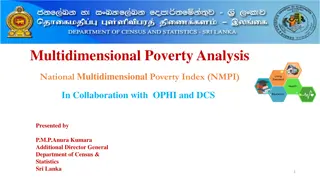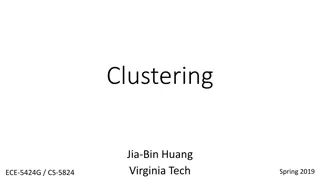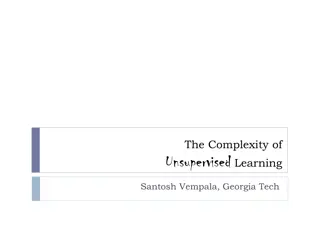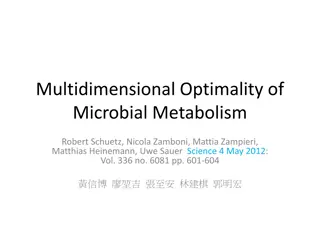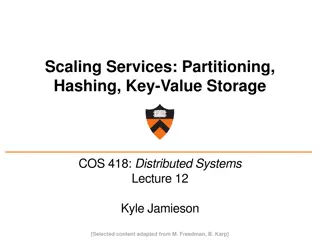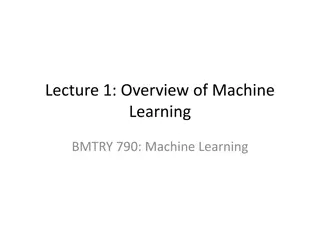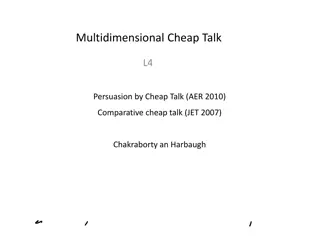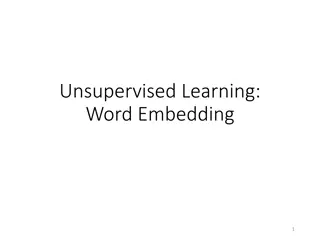Understanding Multidimensional Scaling and Unsupervised Learning Methods
Multidimensional scaling (MDS) aims to represent similarity or dissimilarity measurements between objects as distances in a lower-dimensional space. Principal Coordinates Analysis (PCoA) and other unsupervised learning methods like PCA are used to preserve distances between observations in multivariate data. The methods can be Metric Multidimensional Scaling (MMDS) or Non-Metric Multidimensional Scaling (NMMDS), depending on whether they satisfy the triangle inequality. The objective is to approximate dissimilarities calculated from data in a lower-dimensional space using Euclidean distances. Loss functions are used to evaluate the quality of the approximation.
- Multidimensional Scaling
- Unsupervised Learning
- Principal Coordinates Analysis
- Machine Learning
- Ecology
Download Presentation

Please find below an Image/Link to download the presentation.
The content on the website is provided AS IS for your information and personal use only. It may not be sold, licensed, or shared on other websites without obtaining consent from the author. Download presentation by click this link. If you encounter any issues during the download, it is possible that the publisher has removed the file from their server.
E N D
Presentation Transcript
Math/EEB 589 Math/EEB 589 - - Mathematics of Machine Learning Mathematics of Machine Learning Methods in Ecology and Environmental Science Methods in Ecology and Environmental Science Unsupervised learning methods: Multidimensional Unsupervised learning methods: Multidimensional Scaling example and Clustering Scaling example and Clustering The objective of multidimensional scaling (MDS) is to represent measurements of similarity or dissimilarity between pairs of objects as distances between points in a low- dimensional space. So here you compute distances between points in a high dimensional space and attempt to find an arrangement of the objects in a lower dimensional space so that their distances approximate as close as possible the original distances. Here let X be an N x p data matrix (N observations on p variables) from which a dissimilarity matrix D is calculated. If interested in the observations, D is an N x N matrix and if interested in the variables it is a p x p matrix.
Unsupervised Learning Methods: Principal Unsupervised Learning Methods: Principal Coordinates Analysis Coordinates Analysis PCA and FA are used for quantitative multivariate data and the objective is to preserve Euclidean distances between the observations. There are cases of data for which other distance metrics make more sense, for example in which the data are presence/absence matrices in which each row is a site or sample and the columns correspond to a species or taxon, and the matrix values are binary 1 if present and 0 if not present. For these cases one approach for reducing the complexity of the data is Principal Coordinates Analysis (PCoA). PCA is actually a special case of PCoA when the data matrix corresponds to Euclidean distances. PCoA is also called metric multidimensional scaling.
Unsupervised Learning Methods: Multidimensional Unsupervised Learning Methods: Multidimensional scaling scaling The matrix D={dij} has elements that are dissimilarities between observations i and j that satisfy: (i) a non-negativity property so that dij 0 for all i and j with dii = 0 and (ii) a symmetry property so that dij = dji for all i and j. If the dij satisfy the triangle inequality dij dik + dkj for any k then it is a proper distance metric and the method is called Metric Multidimensional Scaling (MMDS). If the triangle inequality is not satisfied, the method is called Non-Metric Multidimensional Scaling(NMMDS). PCoA is MMDS. The objective is to approximate the dissimilarities calculated from the data in p dimensional space by Euclidean distances calculated in q << p dimensional space and q is typically chosen to be 2 or 3.
Unsupervised Learning Methods: Multidimensional Unsupervised Learning Methods: Multidimensional scaling scaling Let Z be a N x q matrix that contains the coordinates of the objects in the low dimensional space and assume that the quality of the approximation is determined through some loss function such as ?????? ? = ?=1 ?=?+1 (???? ???)2 This is typically normalized by the sum of the squared estimates so what is used is (??????(?) ?<???? This can be modified to account for differences in variability among the components or measurement error by weighting the terms in the sum. These weights can reduce the impact of outliers in the low dimensional space. ? ? 2)1/2
Unsupervised Learning Methods: Multidimensional Unsupervised Learning Methods: Multidimensional scaling scaling The solution process involves some iterative method to reposition the objects in the lower dimensional space (e.g. perturb their locations a bit), recalculate the stress and continue to iterate until the stress does not become smaller. A typical method would include a linear regression step in this process to regress the lower dimensional dissimilarities against those in the data and use this to get a linear estimator in the lower dimensional space and the stress is then calculated using the observed and regressed estimates in the lower dimensional space. NMMDS goal is to place objects that are very different far apart in the low dimensional space while similar objects are placed close with only the rank ordering of the original dissimilarities preserved. The other ordination methods attempt to preserve the original distances.
Example of Multidimensional scaling Example of Multidimensional scaling Principal Coordinates Analysis (PCoA) is also called multidimensional scaling, takes a matrix of interpoint distances, and creates a configuration of points. Ideally, those points can be constructed in two or three dimensions (so this is a dimension reduction method), and the Euclidean distances between them approximately reproduce the original distance matrix. Thus, a scatter plot of those points provides a visual representation of the original distances. A Matlab example illustrates this for the case of genetic distances (or dissimilarity) between populations. A genetic distance between two populations is a measures of how different the allele distributions are in samples of individuals taken from the two populations (there are several different ways to calculate this). A standard question in evolutionary biology is whether the genetic distances between populations are related in some way to the physical spatial distances between populations. In this example there are 8 populations with known geographic locations. We want to know how closely their genetic and spatial distances correspond. If they are similar, it provides evidence that how much interbreeding there is between the populations is affected by their geographic locations.
Example of Multidimensional scaling Example of Multidimensional scaling Let the vector X give the locations of the populations X = [39.1 18.7; 40.7 21.2; 41.5 21.5; 39.2 21.8; 38.7 20.6; 41.7 20.1; 40.1 22.1; 39.2 21.6]; And let the matrix D give the genetic distances (pairwise between the 10 populations): D = [4.69 6.79 3.50 3.11 4.46 5.57 3.00 ... 2.10 2.27 2.65 2.36 1.99 1.74 ... 3.78 4.53 2.83 2.44 3.79 ... 1.98 4.35 2.07 0.53 ... 3.80 3.31 1.47 ... 4.35 3.82 ... 2.57];
Example of Multidimensional scaling Example of Multidimensional scaling It might be easier to see D as a symmetric matrix 0 4.6900 6.7900 3.5000 3.1100 4.4600 5.5700 3.0000 4.6900 0 2.1000 2.2700 2.6500 2.3600 1.9900 1.7400 6.7900 2.1000 0 3.7800 4.5300 2.8300 2.4400 3.7900 3.5000 2.2700 3.7800 0 1.9800 4.3500 2.0700 0.5300 3.1100 2.6500 4.5300 1.9800 0 3.8000 3.3100 1.4700 4.4600 2.3600 2.8300 4.3500 3.8000 0 4.3500 3.8200 5.5700 1.9900 2.4400 2.0700 3.3100 4.3500 0 2.5700 3.0000 1.7400 3.7900 0.5300 1.4700 3.8200 2.5700 0 Then using Matlab s command to carry out PCoA, cmdscale(D) creates a matrix of points (in this case in up to 8-dimensions) that have Euclidean distances that reproduce the genetic distances. This command also gives the eigenvalues and if there are only 2-3 eigenvalues that dominate, it would be safe to use only the coordinates in the 8-dimensions corresponding to these to estimate (in Euclidean distance) how far apart genetically the populations are.
Example of Multidimensional scaling Example of Multidimensional scaling [Y,eigvals] = cmdscale(D); [eigvals eigvals/max(abs(eigvals))] (which shows the eigenvalues and relative magnitudes) 29.0371 1.0000 13.5746 0.4675 2.0987 0.0723 0.7418 0.0255 0.3403 0.0117 0.0000 0.0000 -0.4542 -0.0156 -3.1755 -0.1094 Here the 0 eigenvalue and the negative ones indicate that the genetics distances are not completely Euclidean but there are clearly two very dominant eigenvalues so it is reasonable to use only two dimensions and the coordinates corresponding to these dominant eigenvalues will be used to plot the points.
Example of Multidimensional scaling Example of Multidimensional scaling The matrix Y 3.6513 0.7919 -0.4620 0.1537 0.0424 -0.9787 0.2062 0.0675 -0.4166 0.3435 -3.1073 0.3814 -0.0901 -0.0502 -0.2658 0.5731 -1.4088 -0.4371 0.0230 -0.2742 1.2325 -0.3946 1.2765 0.0954 -0.0834 -0.7021 2.7500 -0.0371 0.1786 -0.0080 -1.4586 -1.5821 -0.1669 0.5082 0.2597 0.7900 -0.7439 -0.1508 -0.4922 -0.0141 Gives the points (in 5-space here due to the 3 non-positive eigenvalues) for the 8 populations in this new space. How poor is the representation using just two dimensions relative to the original genetic distances? One comparison is maxrelerr = max(abs(D - pdist(Y(:,1:2)))) / max(D) Which in this case is quite small 0.1335 Note that pdist(Y(:,1:2)) gives the Euclidean distances between the points just using the first two dimensions in Y
Example of Multidimensional scaling Example of Multidimensional scaling To visualize how the PCoA generated points are as compared to the original locations of the population so we can see if they align or not, you have to do some rescaling since the points generated by PCoA are unique only up to translation, rotation, and reflection. One way to do this is to use the proscrustes command to do a set of rotations, reflections and scaling of the points to match up (in least squares) with the original spatial points for the populations [D,Z] = procrustes(X,Y(:,1:2)); plot(X(:,1),X(:,2),'bo',Z(:,1),Z(:,2),'rd'); labels = num2str((1:8)'); text(X(:,1)+.05,X(:,2),labels,'Color','b'); text(Z(:,1)+.05,Z(:,2),labels,'Color','r'); xlabel('Distance East of Reference Point (Km)'); ylabel('Distance North of Reference Point (Km)'); legend({'Spatial Locations','Constructed Genetic Locations'},'Location','SE ); And this gives
Example of Multidimensional scaling Example of Multidimensional scaling
Example of PCA and Multidimensional scaling Example of PCA and Multidimensional scaling Multidimensional scaling (PCoA) is typically used to reduce dimensions in a data set in which we only have a dissimilarity measures. But if you have the original data values, not just dissimilarities, then you can use PCoA to reduce dimensions by taking a distance measure between the original data, carry out the PCoA, and keep only the first few dimensions. If you use Euclidean distance for the original points, this devolves to PCA (principal components analysis) As an example, create a random matrix and use as a distance matrix the Euclidean distance n = 10; m = 5; X = randn(n,m); D = pdist(X,'Euclidean'); [Y,eigvals] = cmdscale(D); [PC,Score,latent] = pca(X); And the scores in PCA (score = the principal components) are the same as the new points Y in the PCoA and the eigenvalues are the same up to a scaling factor
Example of PCA and Multidimensional scaling Example of PCA and Multidimensional scaling Y = 2.6837 1.1462 0.5562 -0.2208 0.6347 1.6146 0.6027 0.3608 -0.6303 -0.0570 0.0474 -0.3505 -1.2418 -0.5073 0.2825 -2.2427 2.4165 -0.4400 0.9149 0.2767 -2.5601 -0.2388 -1.2025 -0.8975 -0.2742 2.5218 -0.0528 -0.4193 -0.3858 -0.5557 -2.1826 0.2536 1.9286 -0.5524 -0.3577 0.2079 -0.6670 0.4837 0.9864 -0.4531 0.9042 -0.7855 -0.4957 1.1779 -0.2585 -0.9942 -2.3245 0.4699 0.1150 0.7624 [eigvals(1:m) (n-1)*latent] 34.3685 34.3685 14.2285 14.2285 8.2170 8.2170 5.1736 5.1736 1.9277 1.9277 Score = -2.6837 1.1462 -0.5562 -0.2208 0.6347 -1.6146 0.6027 -0.3608 -0.6303 -0.0570 -0.0474 -0.3505 1.2418 -0.5073 0.2825 2.2427 2.4165 0.4400 0.9149 0.2767 2.5601 -0.2388 1.2025 -0.8975 -0.2742 -2.5218 -0.0528 0.4193 -0.3858 -0.5557 2.1826 0.2536 -1.9286 -0.5524 -0.3577 -0.2079 -0.6670 -0.4837 0.9864 -0.4531 -0.9042 -0.7855 0.4957 1.1779 -0.2585 0.9942 -2.3245 -0.4699 0.1150 0.7624
Unsupervised learning: Clustering Unsupervised learning: Clustering Cluster analysis takes a set of observations each with a vector variable, segregates these into groups so that members of the same group are as similar as possible while those in different groups are as dissimilar as possible. Some approaches used in ecology are: agglomerative clustering in which the observations are grouped into successively larger clusters until a single cluster is obtained divisive clustering starts with all the observations in one group and successively splitting them into smaller clusters until each observation is in its own cluster. In both cases, a rule is used to choose the appropriate number of clusters. These are examples of hierarchical clustering in which a hierarchy of clusters is created using a tree
Unsupervised learning: Clustering Unsupervised learning: Clustering K-means clustering specifies a number of clusters and then assigns objects to clusters so that all objects within one cluster are closer to each other (so this requires a distance metric) than they are to objects within the other clusters it minimizes the sums of squares from each object to the centroid of its cluster Gaussian mixture models uses a mixture of multivariate normal density components and views a collections of clusters as the total mixture of these Self-organizing maps use neural networks that learn the topology and distribution of the data
Unsupervised learning: Clustering Unsupervised learning: Clustering Formally, there are N objects O = {o1, o2, , oN} and K subsets of O, C={C1, , CK} with input data either a profile data matrix XNxp of real-valued vectors with p measurements on each object or an NxN dissimilarity matrix that has the pairwise dissimilarities (often computed from the profile though). Clustering is based on distances between points so need to scale the variables appropriately. Clustering methods may not be robust to scaling changes. An issue is what of the variables in the profile to use for clustering more variables may not be better. So it might be good to run a PCA first to assess which variables to include.
Unsupervised learning: Clustering Unsupervised learning: Clustering There are a couple of general forms of clustering algorithms: (i) Partition methods in which a partition of the objects is made so that each object is assigned to exactly one cluster and the clusters do not overlap. Then the partition is made so that distances between pairs of objects in the same cluster are smaller than pairs of objects from different clusters. (ii) Tree-type methods build a tree of clusters that includes all the objects and for which any two clusters are disjoint or one is a superset of the other.
Unsupervised learning: Clustering Unsupervised learning: Clustering Partition methods seek to allocate objects to clusters to meet some underlying optimization criteria. Typically the total variation of objects distances can be viewed as a sum T = W + B where W is the within-cluster variation and B is the between-cluster variation ? = ??? ??????? ?(?? ?)(?? ?) . ? = ??(?? ??)(?? ??) ??? ???????? ? ??? ??????? ? Here ? is the overall mean of the data, ??is the mean of data for objects in cluster k, ??is the number of objects in cluster k. So for a fixed T a clustering algorithm would seek to minimize some measure of W and maximize some measure of B
Unsupervised learning: Clustering Unsupervised learning: Clustering Considering all possible partitions in the above scheme (e.g. exhaustive search) is computationally difficult, so some heuristic methods are used such as K-means which optimizes the objective function ? ? = ?=1 ?? ?? ?? ?? 2 Where ??are the centroids or means of the clusters ??and the norm is the Euclidean norm. Here the value of K is fixed by the user, the algorithm proceeds by (1) assigning initial means ?? to each of K clusters, (2) assign each object with profile ?? to the cluster ?? with the closest mean, (3) compute new means for ?? ???? ?? ??, and (4) iterate until H(K) converges so that there are no new assignments. This requires K and initial centroids to be assigned and it favors spherical clusters. ? each cluster ??= where ??is the number of objects in
Unsupervised learning: Clustering Unsupervised learning: Clustering Matlab has a nice example of K-means clustering and hierarchical clustering (e.g. creating a tree hierarchy of clusters, using the Fisher Iris data. Of course in the Iris case there is an independent set of information about what species each measured flower is in. In a sense then, doing clustering and then comparing to the clusters by which the flowers have been assigned as species provides a way to assess whether indeed the measurement data imply that the 3 species classifications are indeed distinct. The example compares the cases of K=2 and K=3 using sepal and petal lengths and widths.







